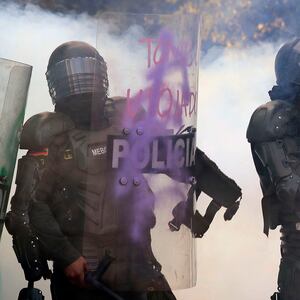BOGOTÁ—As Colombia concludes nine days of nationwide protests with hundreds of thousands of individuals taking to the streets, a dispirited government led by lame duck President Ivan Duque continues to cast aspersions that the marches have been premeditated, organized and financed by illegal groups involved in narco-trafficking.
The concern is what comes after these declarations, as there is neither any sign that the protests—triggered at first by an unpopular tax reform bill—are diminishing in size or spread, nor that the government plans to de-escalate their militarization of towns and cities.
“These actions were organized and financed by the FARC dissident groups and the ELN guerrillas,” said Minister of Defense Diego Molano on Sunday. “Amongst the criminal organizations, we have identified the following movements or groups: JM19, Luis Otero Cifuentes, Gentil Duarte, the escudos azules, and the escudos negros,” added Molano, referring to illegal armed groups involved in cocaine production and trafficking in Colombia.
Part of a tired strategy employed in Colombia which people now openly question, this laundry list of armed groups detailed by Molano has also been repeated by the president and the district attorney. But this narrative feeds into something even more worrying: the possibility that the government, with momentum now firmly with protesters, may declare a state of emergency.
The move to declare a state of emergency, albeit drastic, would permit authorities to skip due process, control the flow of information, make arbitrary detainments, and further erode human rights. Local NGO Temblores has registered 37 homicides, 1,708 cases of police brutality, and 10 cases of sexual violence at the hands of the police since protests began on April 28, and international organizations like Amnesty International have called on authorities to guarantee the Colombian people’s right to peaceful protest.
“They look like war warriors in the early ’90s casting about for a new enemy to accuse their political opponents of colluding with,” Adam Isacson, director for defense oversight at the Washington Office on Latin America (WOLA), told The Daily Beast. “For 50 years they delegitimize peaceful political opponents by accusing them of links to the FARC. Some got killed by paramilitaries—and it was certainly impossible to have a big broad-based protest.”
Isacson added: “Now the big national guerrilla group is gone. But they’re still trying to stigmatize the protesters by tying them to guerrillas. It looks sort of ridiculous now because the new enemy is small, dispersed, and not very ideological.”
Nightly running street battles in smaller towns, in addition to major cities, have led to the government miscalculating the extent of the resentment and polarization in the country. Images of bloodied citizens have flooded social media, footage of police tasering and killing protesters and ARVs popping off tear gas and flash-bang grenades into crowds have circulated on social media, prompting global outrage.
“We are marching for equality and that the injustices, deaths and massacres are brought to an end in Colombia,” Luisa, a student protester in Bogotá, told The Daily Beast. “We’re marching for dignity, education and food.”
The overarching belief amongst protestors is that the government is deaf to the needs of the people and out of touch with reality. Poverty levels rose to 42.5 percent of the population last year amid coronavirus lockdowns, further increasing longstanding inequities within Colombian society. The number of Colombians living in extreme poverty grew by 2.8 million in 2020.
Although the discontent has led to the wanton vandalism and destruction of police stations and public transport systems over the past week, it finds its roots in profound issues. Protesters are demanding that the government commit to the 2016 peace accord with the FARC and prevent further massacres and killings of social leaders in the country. According to Colombian research NGO Indepaz, there have been 33 massacres and 57 killings in 2021 so far carried out by illegal armed groups, a problem that the government has failed to appropriately address.
Other demands voiced by protesters include the outlawing of fracking, acting on rampant police brutality, and putting an end to the spraying of chemicals on coca plants across the country, which are harmful to humans and the environment.
Instead of addressing these concerns, President Duque’s move has been to militarize the country, crack down on the democratic right to protest, and spin information suggesting that what is currently taking place in Colombia is little more than a “narco-terrorist” plot.
It begs the question, who is calling the shots?
“I think the government is talking to its base, which is becoming more radicalized as the protests are evolving,” Sergio Guzman, of Colombia Risk Analysis, told The Daily Beast. “I think they are waiting to see what sticks. This is because the reality sheds a negative light on them as they cannot address the facts.”
While there may be ELN and dissident support networks members taking part in some of the vandalism, there is no evidence to suggest that they’re masterminding it or even commanding very many people.
The question remains: If this cold war rhetoric is unsuccessful, then what comes next?


